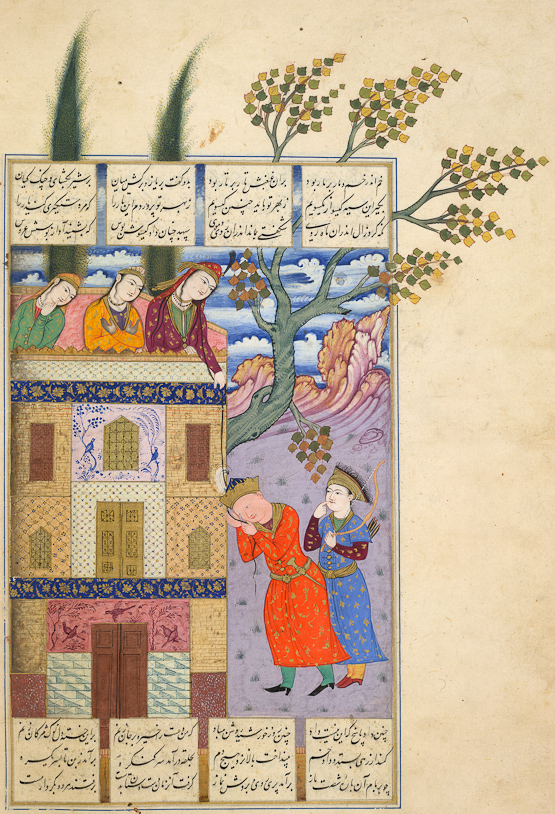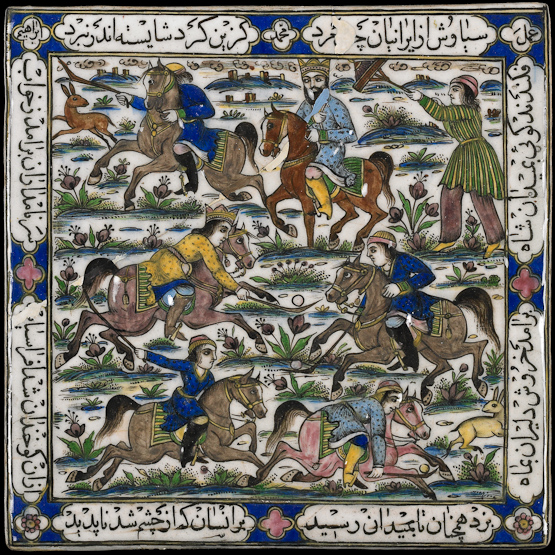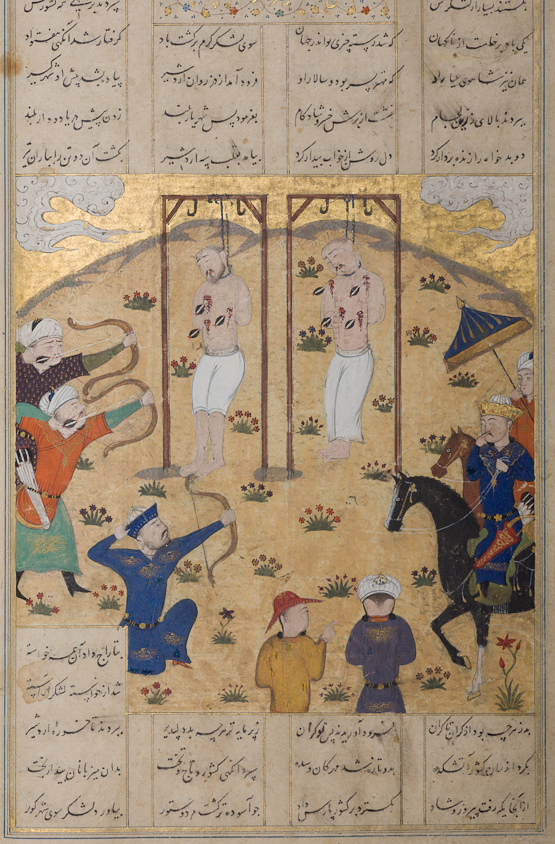
The Shahnameh’s universal themes had struck a resonant chord in the hearts and minds of unfolding generations. Its stories of the rise and fall of great dynasties, the disputes between kings and heroes, and the conflicts between fathers and sons treat man’s struggles against nature, fate and his own conscience. They reflect both long-standing traditions and topical realities.
The Shahnameh is essentially a chronicle of kings, with the larger sections divided according to the coronations and deaths of individual monarchs. It covers the reign of fifty kings, from the first, Kiyumars, down to the ill-fated Yazdegerd, murdered as he fled from the advancing Arabs. Ferdowsi’s kings and heroes are constantly involved in battles, hunts and court receptions – the feasting and fighting, bazm u razm – which were key elements of the warrior code and the pastimes of the ruling elite [No. 3 No. 50 No. 55 No. 61 No. 64 No. 73 No. 74 No. 79] . However, they also find time for sports, games and romance [No. 81 No. 84 No. 89 No. 93]
The various roles of women in the Shahnameh are indicative of Ferdowsi’s views on social order. A good example is the story of Bahram Gur who cruelly punished his beloved, Azadeh, for her audacity [No. 16] . Azadeh was a fine musician, but socially inferior – she was a slave, while Bahram Gur was to become the Sasanian king Bahram V, celebrated in literature and art as one of the last epic heroes. The union of a prince and a slave girl was, according to the Shahnameh’s social outlook, as absurd as Azadeh’s name, meaning ‘free, noble’. On the other hand, Ferdowsi maintained that women of royal descent had equal rights with men when it came to matters of the heart. Tahmineh, the beautiful daughter of the king of Samangan, came to the hero Rostam, who was staying the night in her father’s castle, and offered herself as a mother for his child [No. 18 No. 28 No. 48 No. 75] . Likewise, Manizheh, daughter of the ruler of Turan, Iran’s mortal enemy, ordered the Iranian knight Bizhan with whom she had fallen in love to be drugged and brought to her palace apartments, though their liaison eventually saw him imprisoned in a pit [No. 80]. In both cases the women achieved their goals, regardless of their partners’ wishes, and deserved no punishment in the poet’s view. As one of the last representatives of the old Iranian aristocracy, Ferdowsi was trapped between his traditional values and the new norms of a changing society, which combined the relative social egalitarianism of Islam with a more restrictive attitude towards women’s freedom of choice and action.
The Shahnameh is commonly divided into three sections: myths, legends and history. The mythical part opens with the creation of the world. The borderline between the mythical and legendary sections is porous. The historical part begins with the fall of the Achaemenid dynasty upon the conquest of Iran by Alexander the Great c.330 BC and ends with the collapse of the Sasanian Empire in the wake of the Arab invasions of the early seventh century.

The mythological section of the Shahnameh, by far the shortest, is essentially a cosmogony. Ferdowsi treated the creation of the world in Zoroastrian terms and, unlike his contemporaries, made no attempt to integrate the Islamic version of the creation as recorded in the Qur’an. Much of the worldview of the Shahnameh reflects ancient sources of Indo-Iranian (Aryan) origin, preserved in the Avesta, the scriptures of Zoroastrianism that are at least partly contemporary with the prophet Zarathustra (fl. c.1000 BC). The Zamyad Yasht, for instance, tells the story of the divine grace or charisma (farr, khwarnah), possessed by the deity, prophets and great heroes of Iranian myth, which is the vital element of kingship in the Shahnameh [No. 40]. The supernatural is omnipresent in the mythical part, usually in the form of beasts, dragons or demons who threaten mankind’s attempts to establish an orderly society [No. 47 No. 54 No. 69 No. 71 No. 74 No. 94 No. 101] . The early battles of the poem record the first kings’ gradual subjugation of the demonic representatives of Ahriman, the evil principle of the universe.
The reign of Jamshid, the fourth king [No. 40 No. 102] , was notable for the introduction of crafts and the organization of society. He grouped mankind into four classes – priests, warriors, farmers, and manual labourers – a division that remained axiomatic in later theories of political organization and had its counterpart in the Indian caste system. To reflect his sun-like glory, Jamshid introduced the feast of the New Year, Nowruz, still celebrated in Iran at the time of the spring equinox. However, entranced by his own achievements, he forgot God and lost his divine charisma (farr), leading to his downfall and the subjugation of Iran by the tyrannical king Zahhak [No. 4].
Zahhak’s Arab origins prefigure the long and troubled relationship between the Persians and the Arabs [No. 29 No. 33] . His reign marks the transition to the legendary section, which contains the most famous stories. Some of them are Homeric in tone and themes. Others display similarities to the great Indian epics, the Mahabharata and the Ramayana: the feats of the Shahnameh’s main hero, Rostam, find parallels in the exploits of Indra and Krishna [No. 7 No. 34 No. 35 No. 38 No. 47 No. 66 No. 68 No. 69 No. 71] ; noble characters wrongly suspected of sexual misconduct have to prove their innocence by passing through fire [No. 49 No. 78] ; ethnic and tribal differences have their origins in fratricidal disputes [No. 5 No. 103] .

A formative episode in the legendary portion of the Shahnameh is the murder of Iraj, son of king Faridun, who divided his realm amongst his three sons (not unlike King Lear’s planned division of Britain between his three daughters). The youngest brother, Iraj, received the choicest part, Iran, and his jealous brothers murdered him [No. 5 No. 103] . This set off the cycle of wars that pitted the Iranians against the Turanians throughout the Shahnameh, a reflection of the long-term historical confrontation between the sedentary civilizations of the Iranian Plateau and the nomadic Turkic peoples of Inner Asia. The murder of Iraj had other resonances. He was an innocent victim, politically naïve and ready to renounce the trappings of power for a life of contemplation. As such, he is a precursor of the inward-looking and spiritually aware Siyavosh, a man of conscience who undertook an ordeal by fire to prove his innocence [No. 49 No. 78] . The world of the spirit, though not a dominant feature in the Shahnameh, is always in the background and highlights the uneasy relationship between secular power, religion and ethics.
The stories in the legendary section are more complex than the poem’s opening narratives. One reason for this is the emergence of two centres of power, the Persian kings and the lords of Sistan: Sam, his son Zal, and Zal’s son Rostam [No. 45 No. 46 No. 77] . Although the lords of Sistan are the champions of the Persian kings, the gradually deteriorating relationship between these two ruling houses generates much of the tension in the legendary stories. Sam is unconditionally loyal to his kings. Zal is faithful too, but he warns his monarchs against bad advice and evil actions. Rostam is loyal to wise and just kings, but challenges the inept Kavus and the tyrannical Goshtasp.
Dissension between king and hero is a recurrent motif in the Shahnameh, and this is also a widespread theme in western epics, most famously in the argument between Achilles and Agamemnon at the opening of the Iliad. Indeed, the Persian ‘Book of Kings’ is not a relentless praise of individual rulers or the institution of monarchy. Of the fifty kings named by Ferdowsi, only five are given unalloyed approbation, while many more are shown as unwise or deeply flawed. Towards the end of the Shahnameh, a sage is asked: ‘Who is the most desperate of men?’ He replies: ‘A good man who serves a worthless king.’

In two of the greatest narratives of the legendary section, the stories of Siyavosh and Esfandiyar, a young prince is faced with an impossible moral dilemma: the king, who is also his father, has ordered him to do something wrong. Whereas Siyavosh follows his conscience and goes over to the enemy [No. 89], Esfandiyar obeys his father’s orders [No. 85]. Both are destroyed. The urgency of their moral dilemma makes for wonderfully moving and humane narratives that exemplify another problematic relationship at the core of the Shahnameh, that between father and son. Paradoxically, the greatest loyalty of all, that towards Iran itself, is similarly called into question. The two most unequivocally noble characters of the legendary section, Siyavosh and his son Key Khosrow [No. 53 No. 76], abandon Iran for ethical reasons. Their sense of the moral imperative in their lives transcends their ethnic and national loyalties.
The legendary section of the Shahnameh is dominated by Rostam, the most celebrated champion of Persian folklore whose exploits draw on narratives going back to ancient times [No. 23 No. 34 No. 38 No. 66 No. 71 No. 80] . The arms most closely associated with him, the lariat and the club, are pre-metallic weapons. A complex figure, Rostam embodies the most anarchic and chthonic elements of the poem, representing the atavistic type of hero – the trickster. His patronymic, Dastan, means ‘trickery’. He is associated with an animal known for its slyness, the tiger, and instead of armour wears its talismanic skin, an ancient motif of Indian and Parthian origin. The feathers of a magical bird, the Simorgh, protect him at his birth and in his last combat [No. 77 No. 85]. Rostam lives a long life, serving seven kings, and his character undergoes substantial changes. In the early stories he is a mythological hero, enjoying supernatural protection and emerging triumphant from all conflicts. But after his involvement with Tahmineh [No. 18 No. 28 No. 48 No. 91] and the birth of their son Sohrab, Rostam leaves the world of the heroic, and becomes ensnared in the human. His adventures are now shadowed by anguish and a sense of impending tragedy. He inadvertently kills his son Sohrab [No. 82]; he is unable to save the doomed Siyavosh whom he loves as a son; he is presented with an impossible dilemma during his last major encounter with Esfandiyar [No. 85].
The development of Rostam’s character is indicative of the general evolution of narrative in the Shahnameh. The early stories show emblematic figures acting within archetypal situations, for instance the tale of Faridun and his three sons [No. 5 No. 103]. Gradually, the characters acquire psychological depth and plausibility, notably in the story of Siyavosh [No. 49 No. 78]. In the final, historical section, we encounter figures, such as Bahram Chubineh [No. 79], which are drawn with the detailed complexity found in nineteenth-century novels.

The historical section of the Shahnameh begins only with the last of the Achaemenids, Darius III, and the conquests of Eskandar (Alexander the Great), who is treated as a legitimate Persian sovereign [No. 10 No. 26 No. 29 No. 86]. There is no reference to the founders of the Achaemenid dynasty, Cyrus the Great, Darius, or Xerxes. Their history was lost to the Persian memory, perhaps owing to the lack of records under the Parthians, a dynasty of nomadic Central Asian origin that ruled Iran for some 500 years (c.247 BC–224 AD) after Alexander’s Seleucid successors had faded. The legends of the Shahnameh originated in eastern, Parthian Iran, not in the imperial heartland that was the centre of Achaemenid rule. Consequently, the capital of the Achaemenid Empire, Persepolis, was known to Ferdowsi’s contemporaries as Takht-e Jamshid, ‘the throne of Jamshid’, while the royal tombs near it, with their monumental carvings, were referred to as Naqsh-e Rostam, ‘the image of Rostam’, and believed to represent the exploits of this legendary hero. The Parthians themselves receive scant attention in the Shahnameh, despite their long rule, although the memory of their warlords and leaders survives in the names of some Shahnameh’s protagonists, such as the Godarzian family of Godarz, Giv and Bizhan [No. 80]. The neglect of the Parthians cannot be simply due to an effort by their successors, the Sasanians, to write them out of history, for the Parthian nobility remained a potent force under the new regime.

The only genuinely historical section of the Shahnameh covers the reigns of the Sasanian dynasty (c. 224–642), founded by Ardeshir Papakan, who is glorified as a lawgiver and a model for subsequent rulers [No. 58 No. 99]. Historical figures are often romanticized, their heroic acts of fighting, hunting and dragon slaying chiming with earlier sections of the epic. Nevertheless, with the focus of conflict switching from the East to the West, there are substantial accounts of the wars against Rome, such as the expeditions of Shapur II and Khosrow Anushirvan. Apart from the military encounters, Ferdowsi also mentions cultural exchanges, particularly with India, for instance the introduction of chess and the Persians’ invention of backgammon in response. This occurred in the reign of Khosrow Anushirvan the Just (531–579), fabled for his reforms and his political wisdom, nourished by the vizier and counsellor Bozorjmehr. The necessary combination of just monarch and wise advisor, exemplified by the idealized relationship between Alexander the Great and Aristotle, was an integral part of Persian political thought. The duty to consult, to seek and to offer advice was the best antidote to rashness and folly. But the precarious relations between Anushirvan and Bozorjmehr are also a paradigm for the dangers of serving a monarch and for the destructiveness of court intrigues.
The tone of this last section is different from the ethical, formulaic stories in the legendary part of the Shahnameh. The narratives are full of circumstantial detail. We leave the court and see villagers and townspeople from various social levels. The supernatural interferes only occasionally and magic is rarely mentioned. There are a number of light, amusing stories, while politics are often so venal as to suggest that the Persian Empire was destroyed as much by its own internal corruption as by the Arabs. If the sense of heroic fatalism is largely lost, much has been gained in vivid narrative, intimate pathos and psychological complexity.
The end of the poem, which recounts the fall of the Sasanians and the triumph of the Arabs, is an astonishing tour de force. The last Persian commander – coincidentally called Rostam – writes a long letter to his brother that prophesies the disasters that will befall Iran under Arab rule. Ferdowsi poignantly recalls the glory of the old civilization and its vanity, showing – without apparent condemnation or irony – the stark simplicity of the conquerors and the valour of the newly emerging culture. The Shahnameh is one of the very few indigenous narratives of the Persian people prior to the Arab invasion. Based on original Persian sources, such as the Sasanian ‘Book of Kings’ (Khwaday-namag), the Shahnameh’s account of the Arab conquest is an important witness to the Iranian view on this watershed in the history of the Middle East, often neglected as irreconcilable with the Islamic version of events. Ferdowsi’s epic poem serves as an authentic historical source on pre-Islamic Iran. Moreover, its variety, complexity and depth, the extraordinary ethical concentration of its narratives, the breadth of the human panorama, and the wisdom with which Ferdowsi discusses the timeless themes of power, love and loyalty, together make the Shahnameh one of the most compelling and memorable works of world literature.




